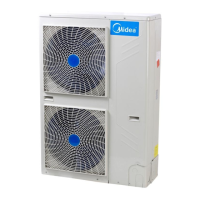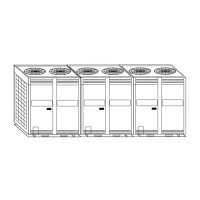R410A DC Inverter VRF V4 Plus Individual Series 50Hz MCAC-VTSM-2014-04
58 Selection Procedure
1. Introduction
Model selection procedure
Select the model and calculate the capacity for each refrigerant system according to the procedure shown
below.
-conditioning load, Calculate the maximum air-conditioning load for each room or
zone.
Selection of an air conditioning system
Design of the control system
Preliminary selection of indoor and outdoor units
Check of the tubing length and elevation difference
Check that the length of refrigerant tubing and the elevation difference are within the allowable ranges
Calculation of the corrected outdoor unit capacity
Capacity correction coefficient for model, outdoor temperature conditions, tubing length and elevation
difference.
Calculation of the actual capacity for each indoor unit
Calculate the corrected indoor/outdoor capacity ratio, based on the corrected outdoor unit capacity and the
total corrected capacity of all indoor units in the same system.
Recheck of the actual capacity for each indoor unit
If the capacity is inadequate, reexamine the unit combinations.
1.2 Indoor unit selection
Enter INDOOR UNIT CAPACITY TABLES at given indoor and outdoor temperature. Select the unit that the
capacity is the nearest to and greater than given load.
Note:
Individual indoor unit capacity is subject to change by the combination. Actual capacity has to be calculated according to the
combination by using outdoor unit capacity table.
Calculation of actual capacity of indoor unit
Because the capacity of a multi air-conditioner changes according to the temperature conditions, tubing length,
elevation difference and other factors, select the correct model after taking into account the various correction
values. When selecting the model, calculate the corrected capacities of the outdoor unit and each indoor unit.
Use the corrected outdoor unit capacity and the total corrected capacity of all the indoor units to calculate the
actual final capacity of each indoor unit.
Find the indoor unit capacity correction coefficient for the following items:
Capacity correction for the indoor unit temperature conditions
From the graph of capacity characteristics, use the indoor temperature to find the capacity correction
coefficient.
Capacity distribution ratio based on the indoor unit tubing length and elevation difference.
First, in the same way as for the outdoor unit, use the tubing length and elevation difference for each indoor
unit to find the correction coefficient from the graph of capacity change characteristics
Capacity distribution ratio for each indoor unit=Correction coefficient for that indoor unit / Correction coefficient for the
outdoor unit
1.3 Outdoor unit selection
Allowable combinations are indicated in INDOOR UNIT COMBINATION TOTAL CAPACITY INDEX TABLE.
In general, outdoor unit can be selected as follows though the location of the unit, zoning and usage of the

